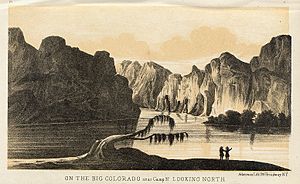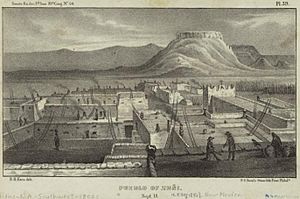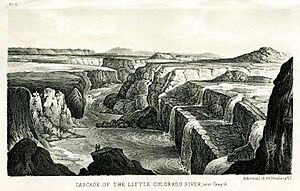Sitgreaves Expedition facts for kids
Quick facts for kids Sitgreaves Expedition |
|||||||
|---|---|---|---|---|---|---|---|
| Part of the American Indian Wars | |||||||
 On the Big Colorado, near Camp 37 by J. Ackerman. |
|||||||
|
|||||||
| Belligerents | |||||||
| United States | Mohave | ||||||
| Commanders and leaders | |||||||
| Lorenzo Sitgreaves | unknown | ||||||
| Strength | |||||||
| 51 infantry | ~55 warriors | ||||||
| Casualties and losses | |||||||
| 1 killed | 4 killed | ||||||
The Sitgreaves Expedition was an important journey made by American explorers in 1851. This mission combined both scientific research and military goals. Its main purpose was to explore and map three major rivers: the Zuni River, the Little Colorado River, and the Colorado River.
The expedition started in northern New Mexico. From there, the group traveled west across what is now Arizona. They then moved south along the Colorado River until they reached Fort Yuma in California. During their journey, the explorers faced challenges, including an attack by Mohave Native Americans. A short battle took place, and the Mohave group eventually moved away.
Contents
Why the Expedition Happened
After the Mexican–American War in 1848, the United States gained a lot of new land, including parts of what are now Arizona and New Mexico. Many people, like mapmakers (topographers) and scientists who study nature (naturalists), were very interested in exploring the large rivers in these new areas.
In 1850, a special trip was planned for this purpose. The United States Army was also interested because they wanted to know if these rivers could be used by river steamers (boats powered by steam). Before railroads were built across the western United States, rivers were a very important way to travel and move goods.
Starting the Journey
Captain Lorenzo Sitgreaves was chosen to lead this important expedition. He was part of the United States Army Corps of Topographical Engineers, a group that specialized in mapping land. Captain Sitgreaves set out in September 1851 from the Zuni Pueblo in New Mexico. His group included fifty infantry soldiers, some porters (people who carry supplies), and a small team of scientists and explorers.
The expedition first traveled through the Petrified Forest, which is known for its ancient, fossilized trees. They then reached the Zuni River and followed it southwest. The Zuni River eventually meets the Little Colorado River, just north of where Woodruff, Arizona, is today.
Exploring New Lands
From the Little Colorado River, the Americans headed northwest. They had to go around a deep canyon where the river flowed. During this detour, they discovered the Wupatki Ruins, which are ancient Native American structures. They then made a long turn around the south side of Bill Williams Mountain. Finally, they reached what is now called Union Pass, near Bullhead City, and found the mighty Colorado River.
Up to this point, the journey had been mostly peaceful and interesting. The mapmakers drew detailed maps, artists sketched pictures of animals and landscapes, and the soldiers made sure the group kept moving forward.
Meeting the Mohave People
After traveling a short distance south along the Colorado River, Captain Sitgreaves' men saw signs that Native Americans were nearby. Soon after, they met the Mohave people at their camp. At first, the meeting was friendly. The Mohave invited the Americans to a pow wow, a gathering where the two groups exchanged gifts and talked.
Captain Sitgreaves noted that the Mohave brought many different kinds of fruits and vegetables. This suggested that they were interested in trading with the Americans. However, the friendly mood did not last. One October night, the Americans felt that the Mohave visitors had stayed too long and asked them to leave. Some Mohave women protested this request.
The next morning, several arrows were shot into the American camp. One arrow wounded the expedition's doctor in the leg, but he was able to treat himself and prevent serious harm. Captain Sitgreaves decided it was best to pack up camp and move on. The Mohave allowed them to leave without further conflict.
Around October 22, the Americans reached another Mohave village. Here, they met a Mohave person who spoke Spanish. This person told them that Fort Yuma and the mouth of the Gila River (which connects to the Colorado) were only about eight days away. The Americans gave gifts to the Mohave elders again, but they remained cautious, worried about another incident.
Conflict and the Final Stretch
The very next day, as the Americans continued their journey, one soldier fell behind the main group. He was attacked by about fifty-five Mohave warriors, who were armed with bows and had stripes painted on their bodies. The soldier was killed. The warriors then moved forward to attack Captain Sitgreaves' main group.
When Captain Sitgreaves realized they were under attack, he quickly sent out skirmishers (soldiers who fight in small, scattered groups). In a short battle, four Mohave warriors were killed, and some others were wounded. The only American casualty was the soldier who was killed first; the Mohave took his musketoon (a type of short rifle).
From there, the expedition continued for about another week. They finally reached Fort Yuma on November 30, 1851. By this time, they were nearly starving and had lost most of their equipment. At the fort, Captain Sitgreaves found that the outpost itself was also very low on supplies. Because of this, the expedition members had to cook and eat all of their mules before they could continue their journey to San Diego.
What Happened Next
Even though the journey was very difficult and dangerous, the expedition was considered a success. The Zuni, Little Colorado, and Colorado Rivers were all mapped in detail. This information was very helpful for settlers who wanted to move west, as it showed them a possible route.
The rivers were found to be fully navigable, meaning boats could travel on them. After this, more and more river steamers and schooners (types of sailing ships) began to use the Colorado River for transportation. Captain Sitgreaves wrote a detailed report about the expedition in his 1854 book, Report of an Expedition Down the Zuni and Colorado Rivers.



